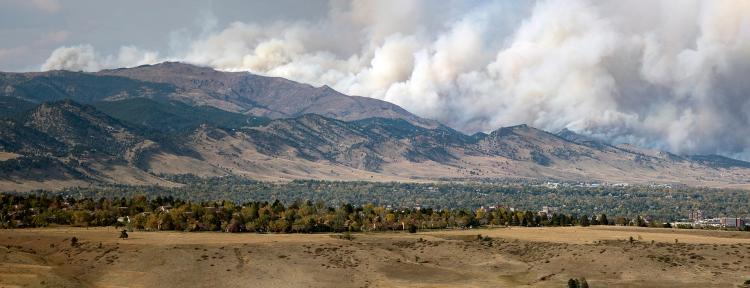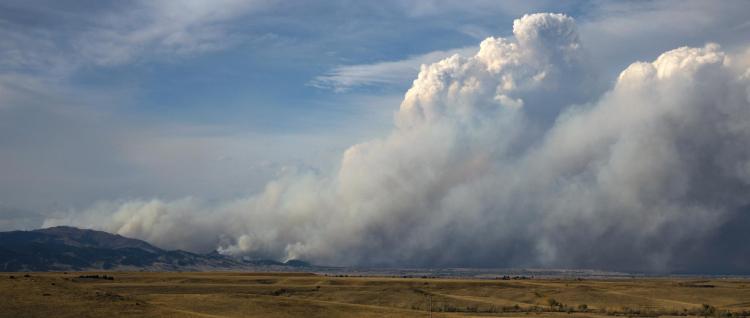Record heat and extreme drought produced our worst fire season
The fires are devastating and the smoke is miserable and unhealthy
The CalWood fire started about noon on October 11 near Jamestown and in two days it ran more than 10 miles to the east, out of the mountains and onto the plains. Boulder residents were acutely aware of the wildfires, for they had been breathing smoke since the Pine Gulch fire started near Grand Junction on July 31. But the proximity of the CalWood Fire and the sight of roiling smoke rising and forming pyrocumulus clouds at the northern edge of Boulder brought the terrible threat home. Persistent palls of smoke and local fires prompt two questions: Is fire season or smoke season getting worse, and if so, why?
We may be experiencing another record, for more likely than not 2020 will be the hottest year in history."
As of October 29, more than 47,000 have ignited in the west, burning more than 8.5 million acres. An analysis of the numbers of acres burned in the US from 1985 to the present shows a steady and dramatic increase from a little more than 2 million to more than 8 million per year--the number of acres burned has more than tripled in the last 35 years! In 2002, the Hayman fire was the largest fire in the history of Colorado. But this year, the Cameron Peak, East Troublesome and Pine Gulch fires all exceeded the size of the Hayman fire. So, Colorado's three biggest fires occurred this year.
The Mullen fire burned in the Medicine Bow Mountains in Wyoming and Colorado this summer, but because most of the fire was in Wyoming, it is not considered in our accounting of fires. But if this fire was also considered, it would be our third largest fire in history and then Colorado's biggest four fires would have occurred this year. In addition, this has been the worst fire year for California, Oregon and Washington as well.
This has been a record year for heat. Denver recorded a new all-time record of 74 days in the 90s. For average global temperature, the last 5 years are the 5 hottest years in history -- temperature data reach back to 1880. We may be experiencing another record, for more likely than not 2020 will be the hottest year in history.

At the top of the page: The smoke of the East Troublesome fire being swept toward Boulder from the north by a cold front. Above: A panorama shot of the Calwood fire, as it raced from Jamestown to the plains in two days. Photos by Jeff Mitton.
A model explaining the link between climate change and wildfires was published by the Union of Concerned Scientists initially in 2011 and updated this year. First of all, since 1850, human activities have raised the concentration of atmospheric CO2 by 47 % (from 280 to 411 ppm) increasing global temperature by 1.9 degrees Fahrenheit (1.09 degrees Celsius). Higher temperatures melt snow earlier in spring, increasing the length of the growing seasons. As temperature increases relative humidity declines. Warmer air, drier air and longer growing seasons work in concert to make forests drier. Finally, drier fuels are associated with both more numerous and larger forest fires.
Climate change is real and its impacts are clearly evident as longer growing seasons, shrinking glaciers, higher temperatures and longer fire and smoke seasons."
An increase of global temperature of 1.9 degrees F is considered to be trivial by many citizens, for this temperature is greatly exceeded by the seasonal increase from winter to summer, or differences in winter temperatures from year to year. Too many people take pride in their skepticism of the reality and progression of climate change. To engage skeptics, I remind them that when Glacier National Park was established in 1910 it had 150 glaciers. Since then, the temperature measured in the Park has increased 2.39 F (1.33 C), and 125 glaciers have disappeared, leaving only 25. The remaining glaciers are predicted to disappear between 10 and 30 years from now. Similarly, scientists are modeling the disappearance of Arctic sea ice, to predict when we will see the first year in which the Arctic Sea is devoid of ice in summer--predictions vary from a few years to 20 years from today. When Robert Peary made his famous trek to the north pole in 1909, the 500 miles between Ellesmere Island and the North Pole was solid ice.
Climate warming started with the Industrial Revolution, which began slowly in 1750 and accelerated in 1850. Human use of fossil fuels to heat homes and power machines inadvertently increased atmospheric CO2. Carbon dioxide in the atmosphere does not modify incoming solar radiation, but does filter the longer length waves that release heat from the earth into space at night, retaining heat. Logan Glacier in Glacier National Park began its retreat around 1850.
Climate change is real and its impacts are clearly evident as longer growing seasons, shrinking glaciers, higher temperatures and longer fire and smoke seasons. The fires are devastating and the smoke is miserable and unhealthy. Tragically, the increase in atmospheric CO2 is still accelerating. It is time for us to take responsibility for the host of negative consequences of our production of CO2.

The Calwood fire generated a pyrocumulus cloud, also called a flammagenitus cloud--looks like a thunderhead. Photo by Jeff Mitton.

